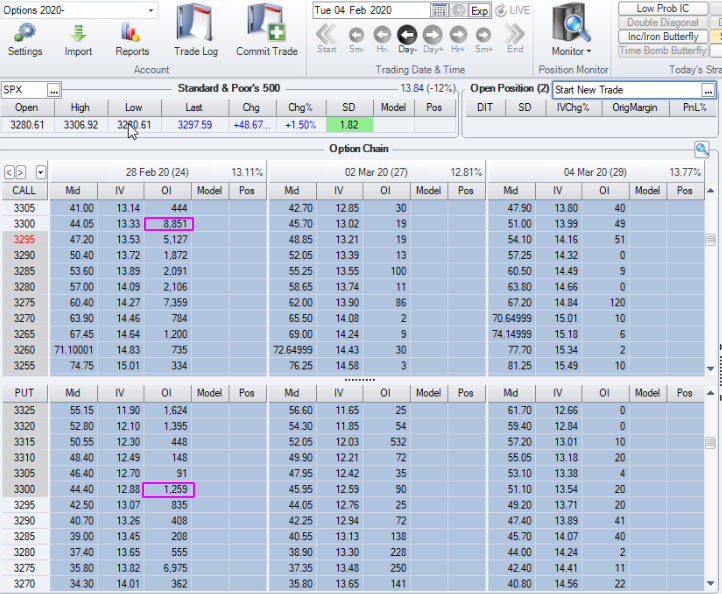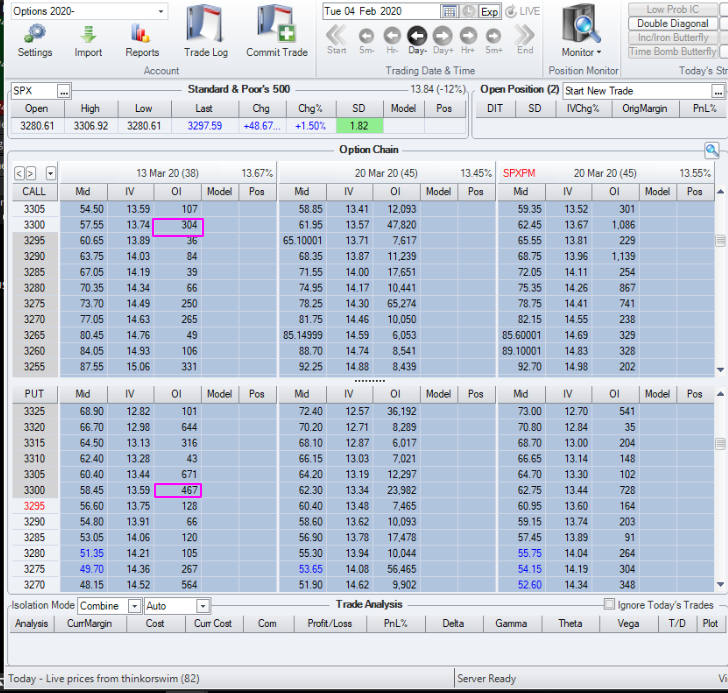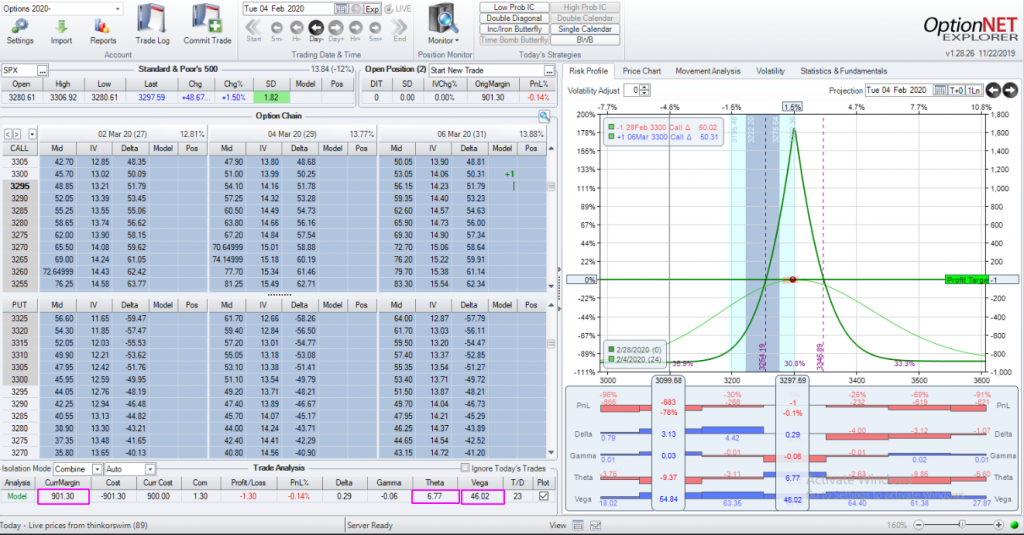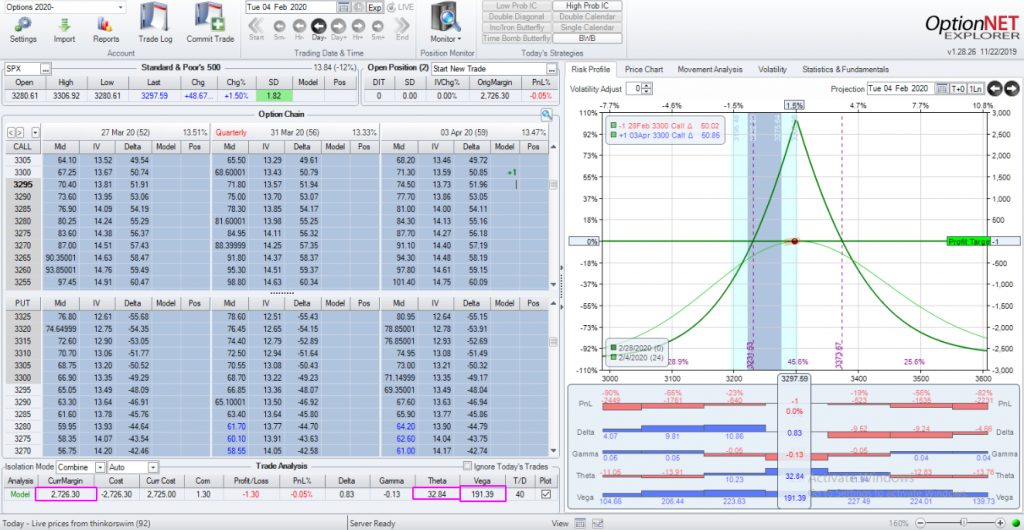Midway Mail: Questions on My Calendar Setup
Originally posted February 4, 2020
I always say I enjoy getting questions and fostering discussions and while I have been getting some very good feedback, I have found some questions that I think can be better answered in this forum than in email. I will keep the viewer anonymous, of course, but I think many traders out there could benefit from my answers and even come up with other (better?) ideas as well. I’m here to learn just as much as anyone so maybe someone out there has some better ideas and I’ll change my mind. All good stuff.
The viewer has some questions around the calendars I put on over the last few months. If you aren’t familiar with Calendars, check out Episode 13 my Options Fundamentals series. It should give you the basics of the trade and how it works.
Question 1: Why do my calendars more often than not start on the call side?
This is a great question and there isn’t one correct answer for everyone with respect to which side to use when setting up a calendar. When considering this, the first thing to determine is why you want to put a calendar on in the first place. This seems obvious, but I’ve seen lots of new traders put on trades without knowing why. There are traders who put on calendars to get a cheaper long call or put. They really want to be long a call or put but want to sell something against it to help pay for it. In this scenario, the ideal situation would be for the short to expire worthless leaving them with just a long call/put at a cheaper price since they got to keep the premium from the short option. In this case, it really matters which long option you want to have if the trade is successful. You really want to be directional, so you would choose the direction you want by choosing calls or puts.
However, that is not why I put on calendars. I am not a directional trader (outside of a rare speculation play) so for me, calls or puts isn’t nearly as important for my calendars. The reason I put on a calendar is that it is positive Theta and Vega and there times when I want those factors working in my favor. I almost always like Theta to be positive as I prefer time to work in my favor, but if the volatility of the underlying is low, I would rather be long volatility when trading it. I believe fundamentally that volatility is mean reverting, meaning that it always returns to the average. So when the volatility of my underlying is low, I would rather be long volatility since I believe it will go up. Conversely, when volatility is high, I like to be short volatility (negative Vega) since I believe it will go down. Of course, I cannot know how long it will take for this to happen, but the idea is to set up my trade to have the best chance to be helped by volatility. Since I also have time working in my favor, I can profit from that even if I don’t get the volatility move I expect, it just may take longer to get to my target profit.
Now that I’ve explained my goals of a calendar, I’ll try to (finally) answer the question. The answer is that, for me, it doesn’t really matter whether I start my standard at the money calendar in calls or puts. I intend to take it off as a spread so I’m not worried about which long I will have left. So how do I choose? I look at the open interest of the calls and puts that I intend to use and I pick the side that has the larger overall open interest.
So what is open interest? It’s a count of how many open positions exist on that particular option. It doesn’t matter if that open position is long or short so long as it’s open. This statistic gives us an idea of the liquidity of that particular option. The more open positions, the more interest there is in that particular option, the better the chance of getting good fill price with little to no slippage. Again, there are no guarantees here, but the idea is to put on a trade with as many factors in its favor to succeed. So if I have time on my side, potentially volatility on my side, and good liquidity so I’m not paying up for the position, I should have a better chance of success. Of course, price risk is always there as a calendar has risk on both sides as it’s a range-bound trade. But as I always say, this market pays me to take risk so there will always be risk somewhere.
So why did I end up choosing calls to start my position more often? Because during that time, the market was trending up which made calls more popular than puts. There could very easily be other times in the market when puts are more popular. So the preference for calls simply resulted from more open position in calls most likely caused by an upward moving market.
Let’s take a quick example. Let’s say I wanted to put on a calendar in SPX right now (note: I would not do that as volatility is too high, but this is just an example). I’ll do my usual shorts about 24 days out and my longs 14 days later (more on that later). Let’s look at the open interest of each of my options:

Open Interest on shorts of a potential calendar
So, let’s assume I want to set up a calendar at the 3300 strike. So I choose 24 days for my short, and compare the open interest in the calls and puts. As you can see, the calls have a large advantage. But let’s also look at the options 14 days later

Open Interest on the longs of potential calendar
So, in this case, the puts have a slight advantage over the calls. But it’s not enough to overcome the advantage of the shorts so I would start with calls here. It turns out today was a large up day so, again, it’s not surprising that the nearer term calls had such a large advantage.
None of this is to say that choosing the puts would be bad or wrong. Remember that using calls or puts doesn’t really matter to my calendar since I’m not worried about keeping the longs. And if I were to adjust the trade, I would most likely put on another set of calendars and I would use the puts for that to help keep my two calendars separate.
Question 2: Why are your calendars 2 weeks between the legs?
Another very good question and, again, there isn’t a perfect answer here. This has become a matter of preference for a couple of reasons. The first is this is the way I was originally taught to do the trade so there is some bias there. But, I keep doing it this way as I like the balance I get of risk and reward. All trades have risks and rewards and that ratio can be adjusted based on how the trade is entered.
As a quick reminder, a calendar is where I sell options and buy the same number of options at the same strike at some point later than the options I sold. It is this structure that gives the calendar it’s characteristics of being long Theta and long Vega. Why? A nearer term option has faster time decay than the same option further out in time. And in a calendar I am short the nearer term option so that is what gives me my time benefit (positive Theta). To get positive Vega, I buy my longs further out in time. Options further out in time have more volatility risk and since I am long the option that is further out in time, I get a positive Vega position.
So how does distance between the strikes affect the Greeks of the position? The further the distance in time between the legs, the greater the difference in the rate of time decay and so the result is more positive Theta. Similarly, the greater the distance in time between the legs, the greater the difference between the volatility risk and so the result is more positive Vega.
So why would I only choose 14 days? Surely, it would be better to increase the distance between the legs and get really high Theta and Vega working for me, right? Of course, there is no free lunch in this market and the price to be paid for having a large distance between the legs of a calendar is … price. In a calendar I am buying the further out option which has more extrinsic value (time and volatility) while being at same strike. This means that the greater the distance between the legs, the more the price of the longs will be compared to the shorts, which yields a higher debit for the trade which, in this trade, is my total risk. So I have to pay for the extra Theta and Vega with money from my account because the trade is more expensive. Let’s look at two examples:

A 24 day calendar with 1 week between legs
In this example, I have a simple calendar with the short 24 days out and the long 1 week later. This gives me 6.77 Theta and 46 Vega and will cost about $900. Now let’s push the long out to 6 weeks from the short:

A 24-day calendar with 6 weeks between legs
So this the exact same calendar but with the legs 6 weeks apart rather than 1 week apart. Here I get 32.84 in Theta, and 191 Vega which is much longer for both. But the cost of the trade is now $2726. So I have to spend about 3x more in capital to get the boost in Theta and Vega. That may look like a bargain, and there’s nothing wrong with taking that trade, but remember that Vega is a 2-way street. While it will be great if volatility goes up on this trade vs the 1-week trade however, if volatility goes down, I get hurt that much more as well. The other risk to consider is Gamma risk. While my deltas on these trades are similarly small, the Gamma is higher on the 2nd trade. While Gamma starts out small on both trades, the it will move Delta faster on the wider trade than the narrower one. This increases my price movement risk in a live market even though Delta starts off very neutral on both trades.
The Choices are Yours
I say all of this to say there is nothing bad about either trade as long as you, as the trader, understand the risks vs the rewards. There are many ways to set up a calendar to make these risk decisions. It’s up to the individual trader to decide what risks are worth taking versus the reward of the trade succeeding. A blog post is not the place to cover all of those possibilities but I did want to address the specific risks as it related to the questions asked. I hope this helped clarify what I’m doing as well as get you think about how to set up your trades.
Thank you again so much to the viewer who asked these questions. And I am very open to further questions or thoughts on anything on this site as well as trading in general. Feel free to follow-up here on the blog or reach out to me directly at midway@midwaytrades.com.
Until next time….. Good Trading!
This content is free to use and copy with attribution under a creative commons license.